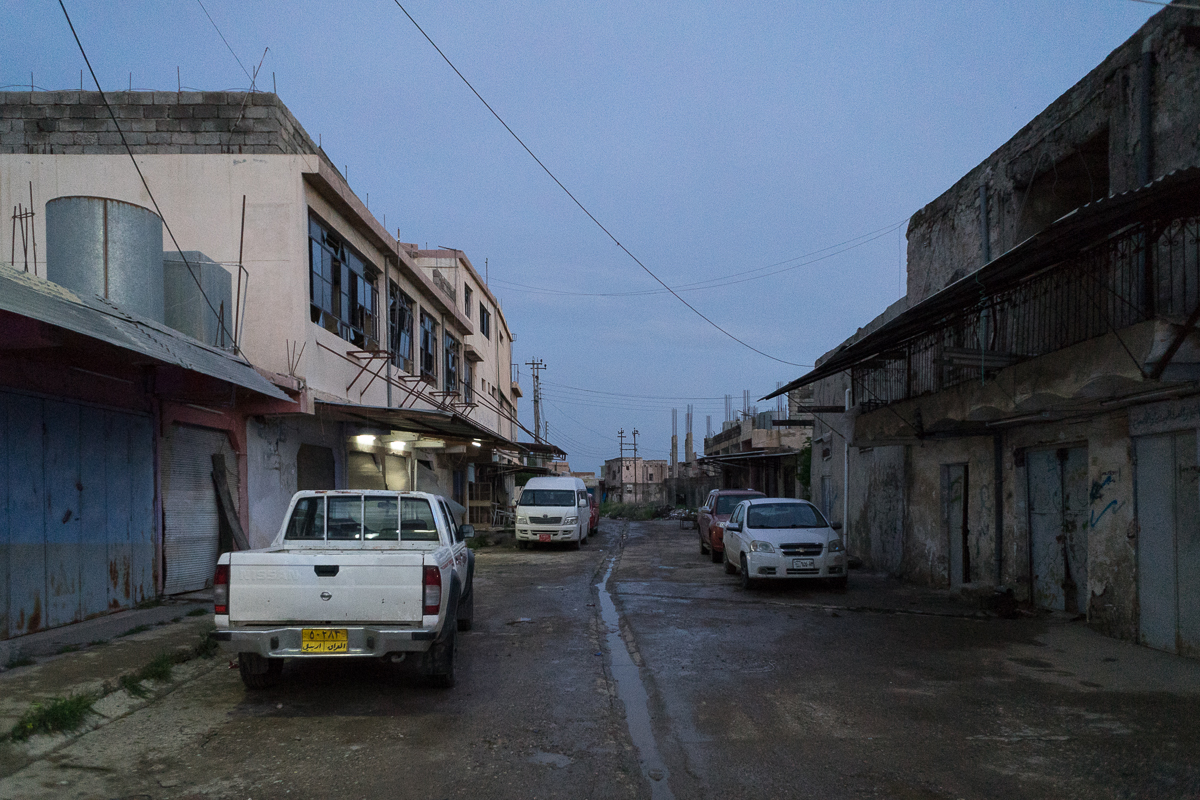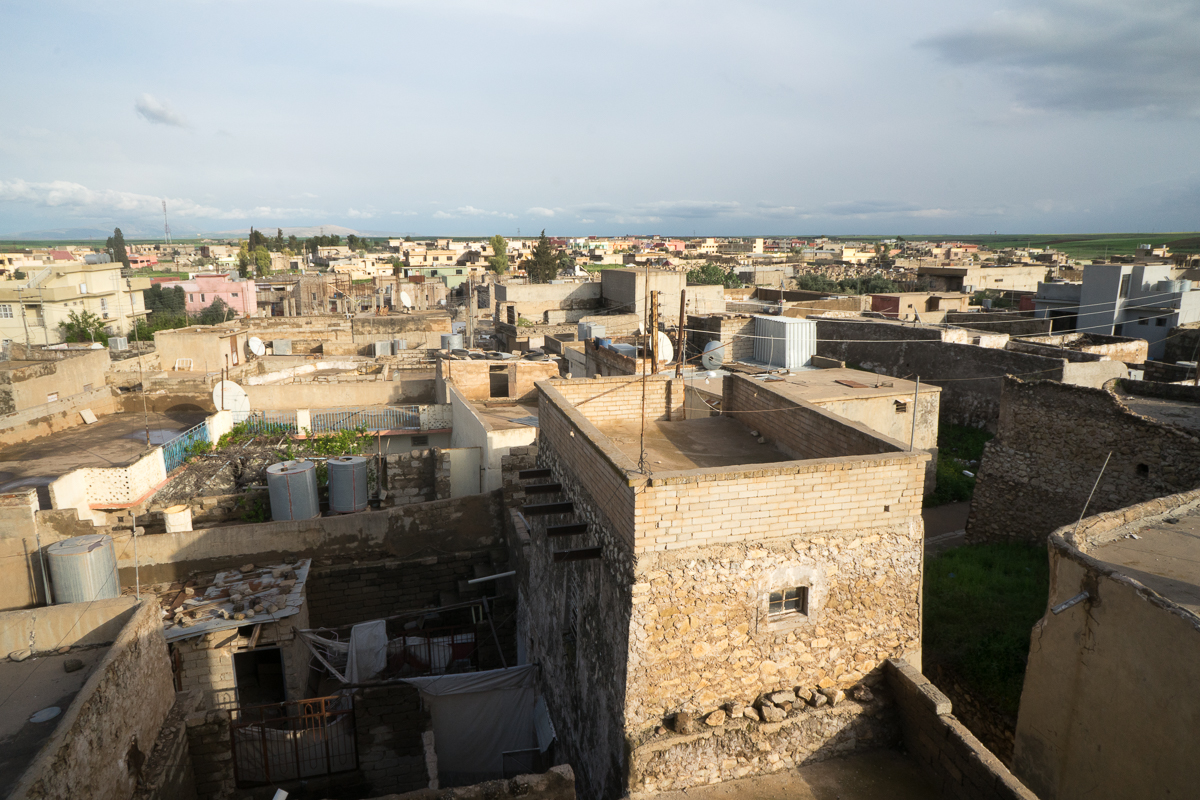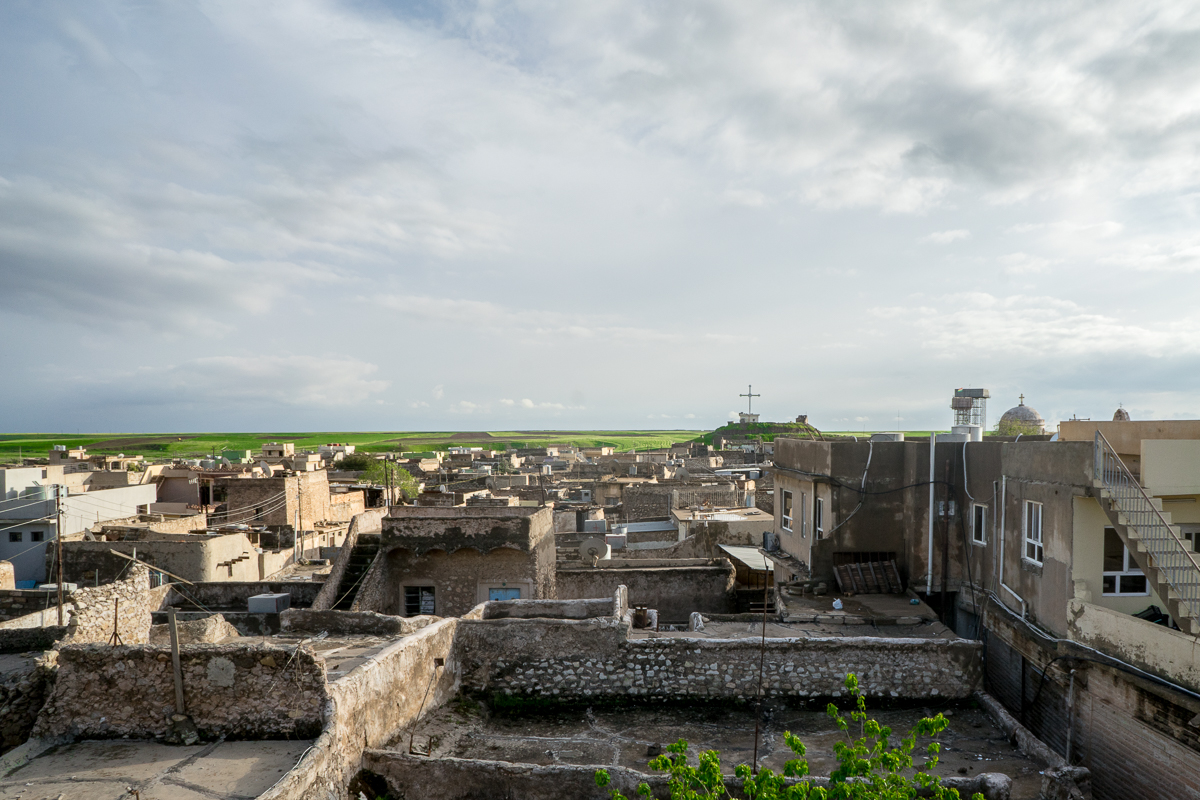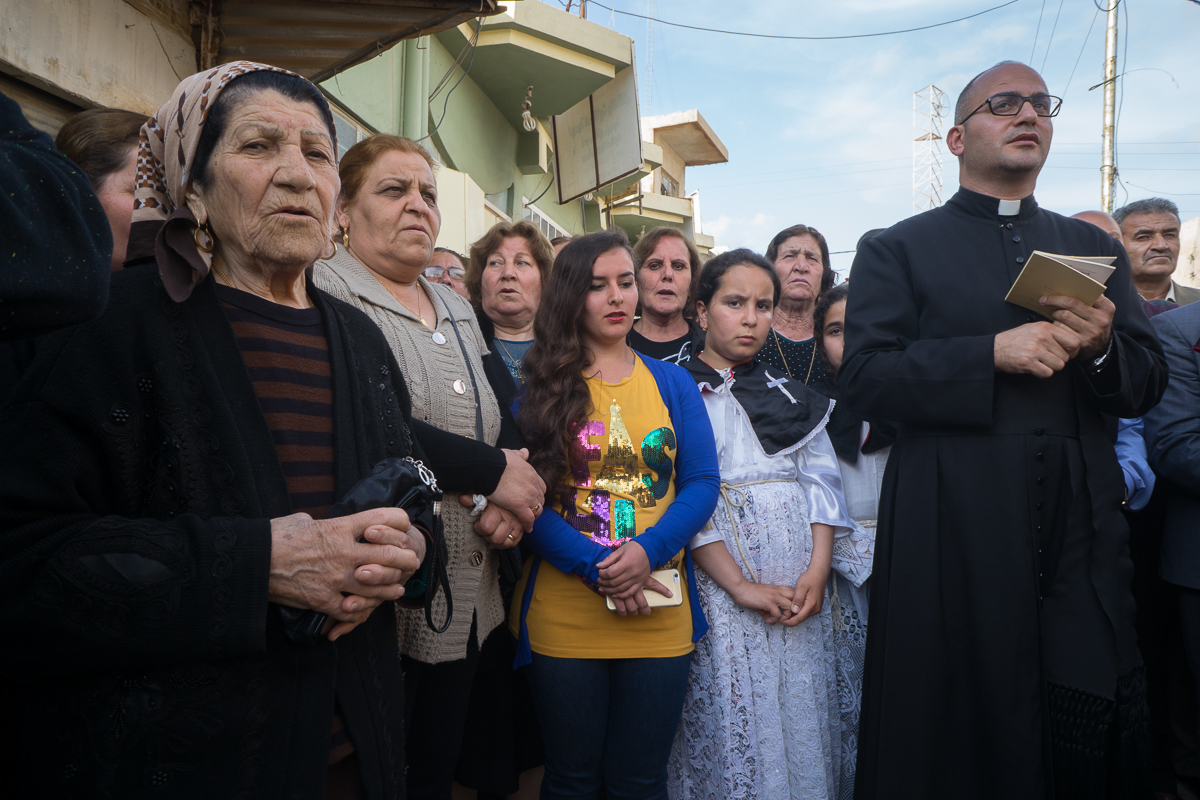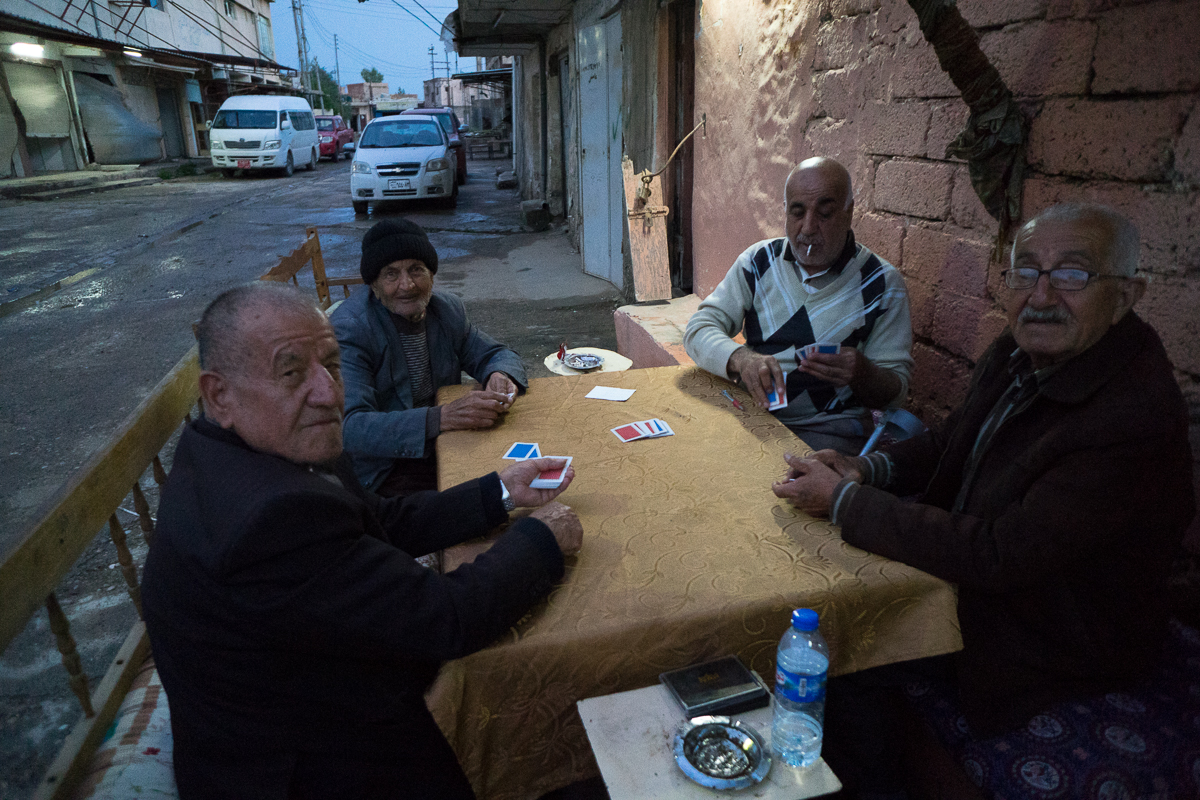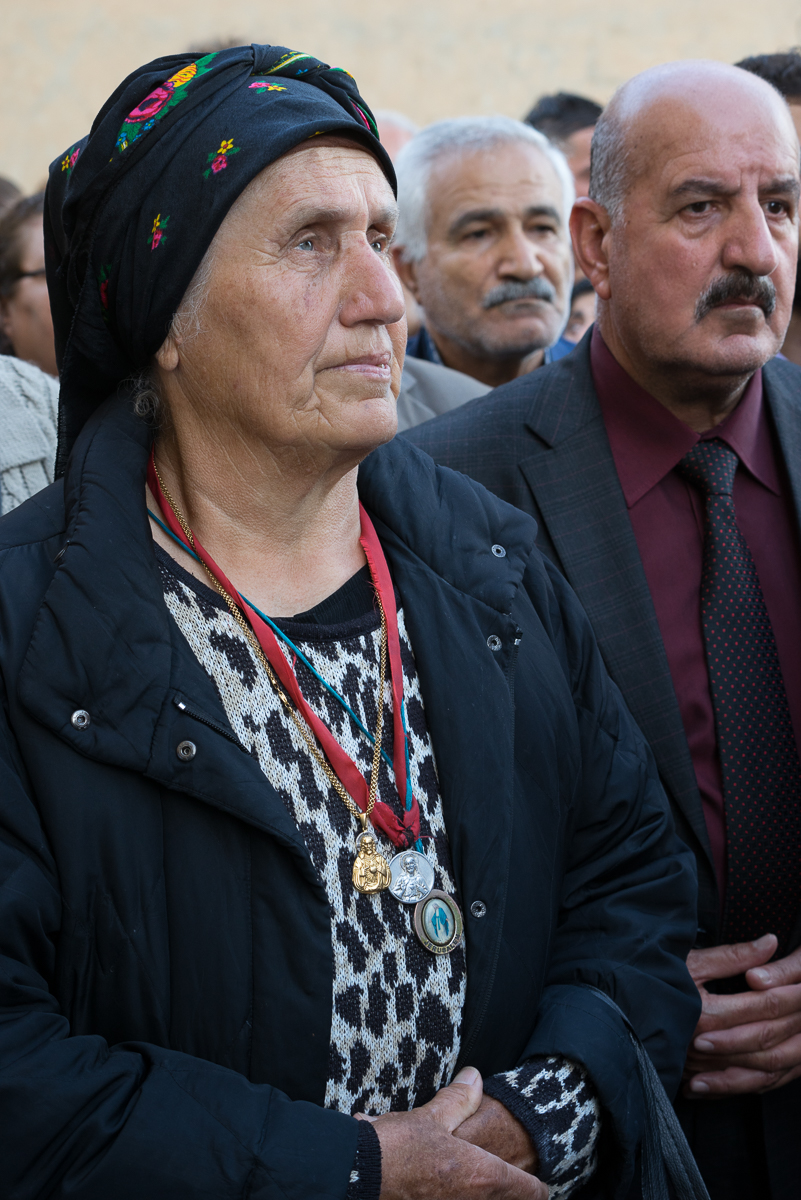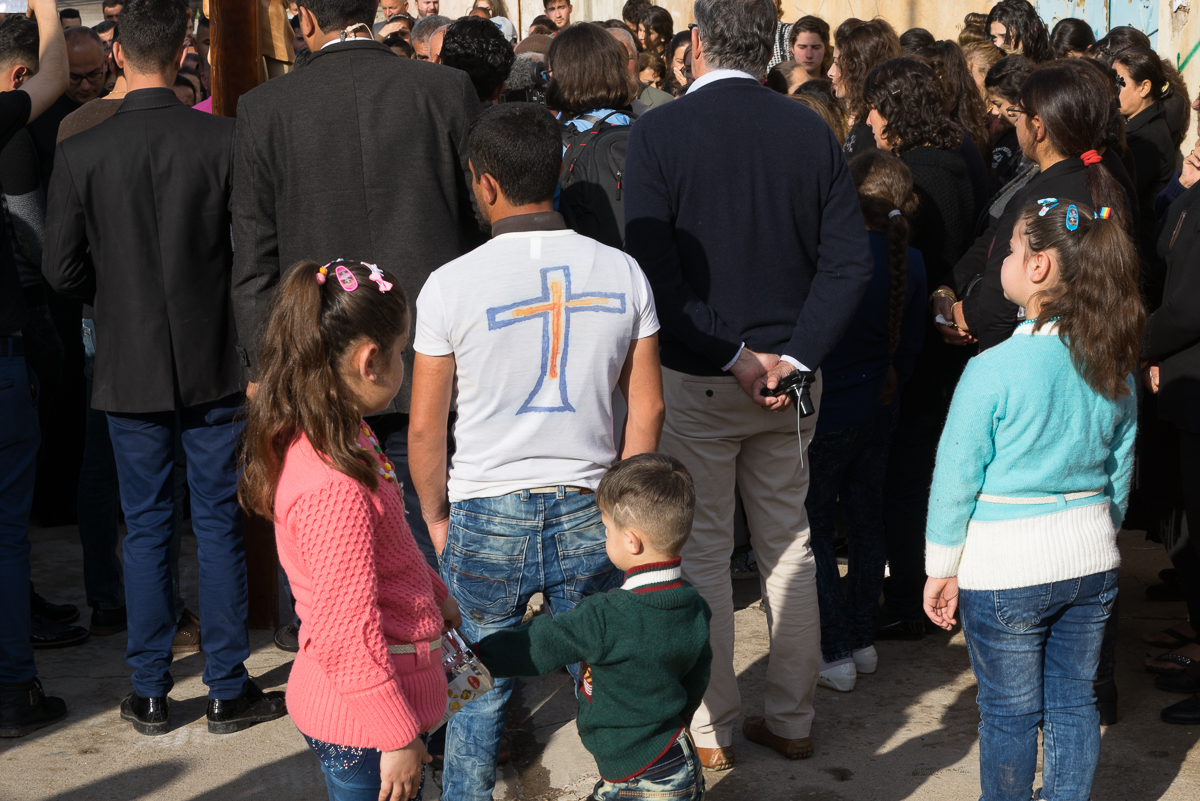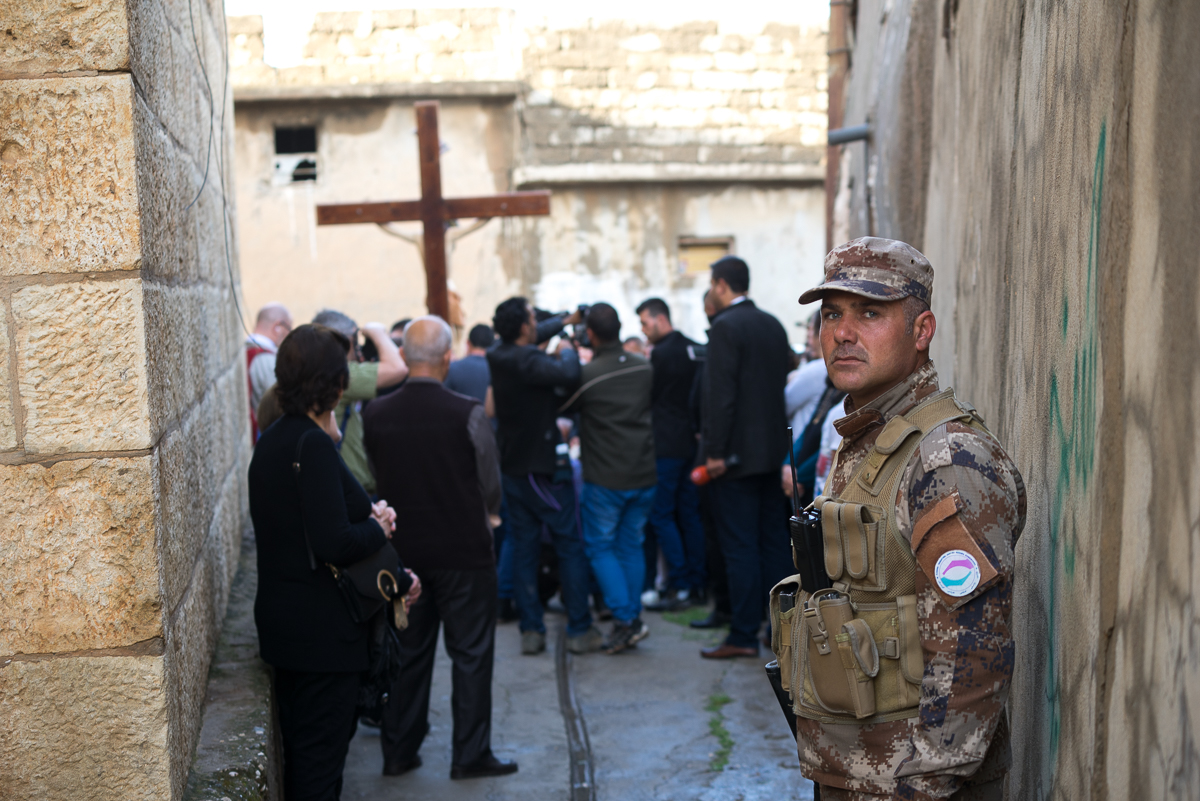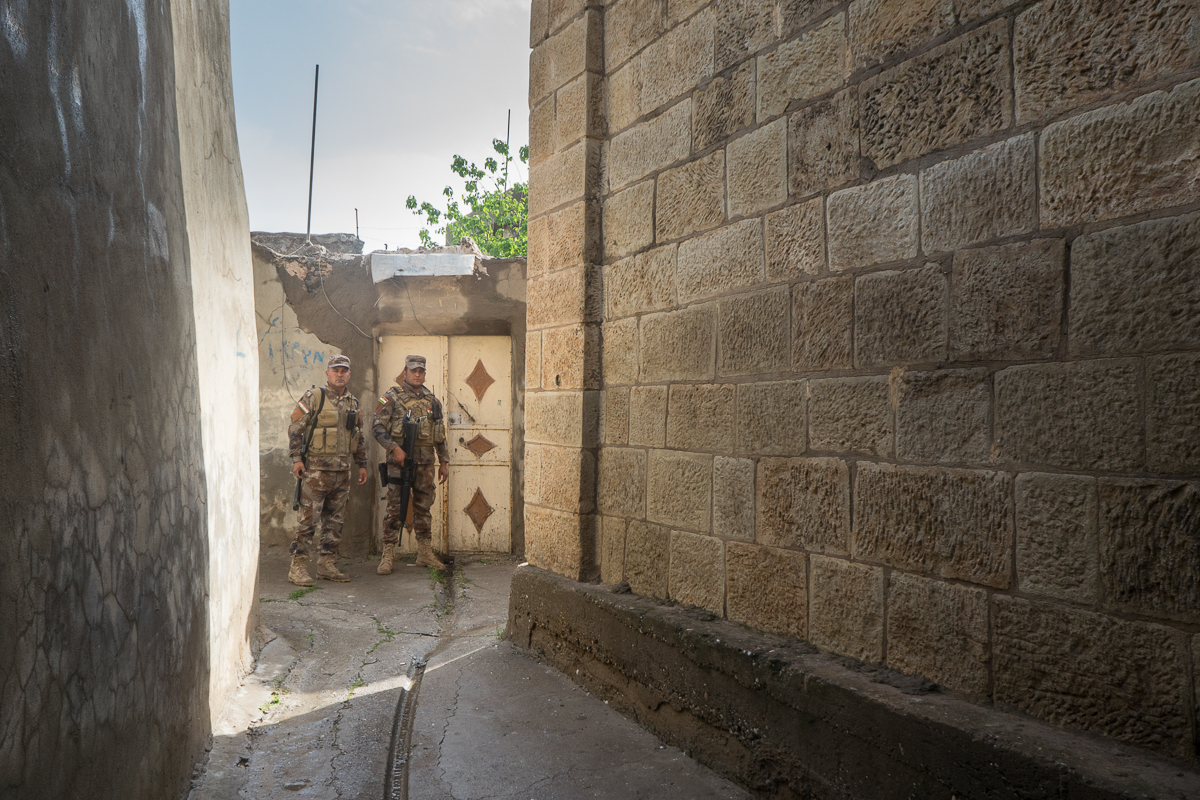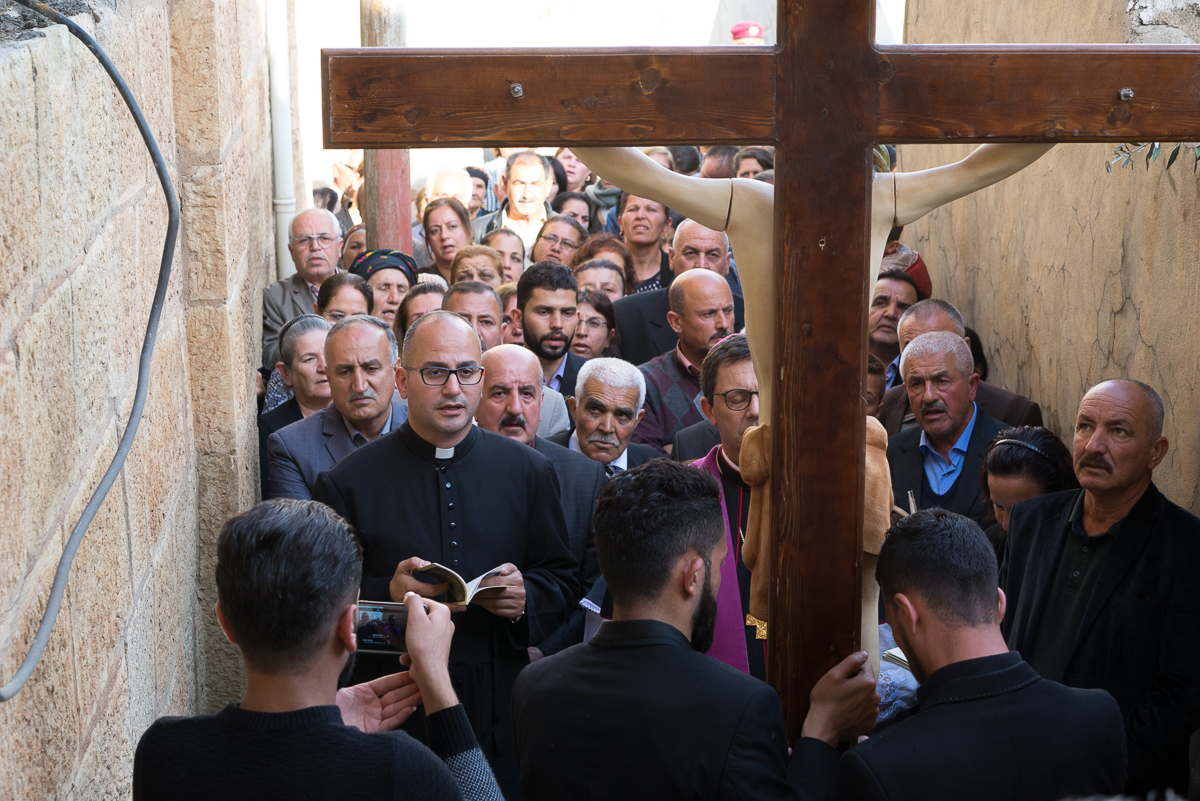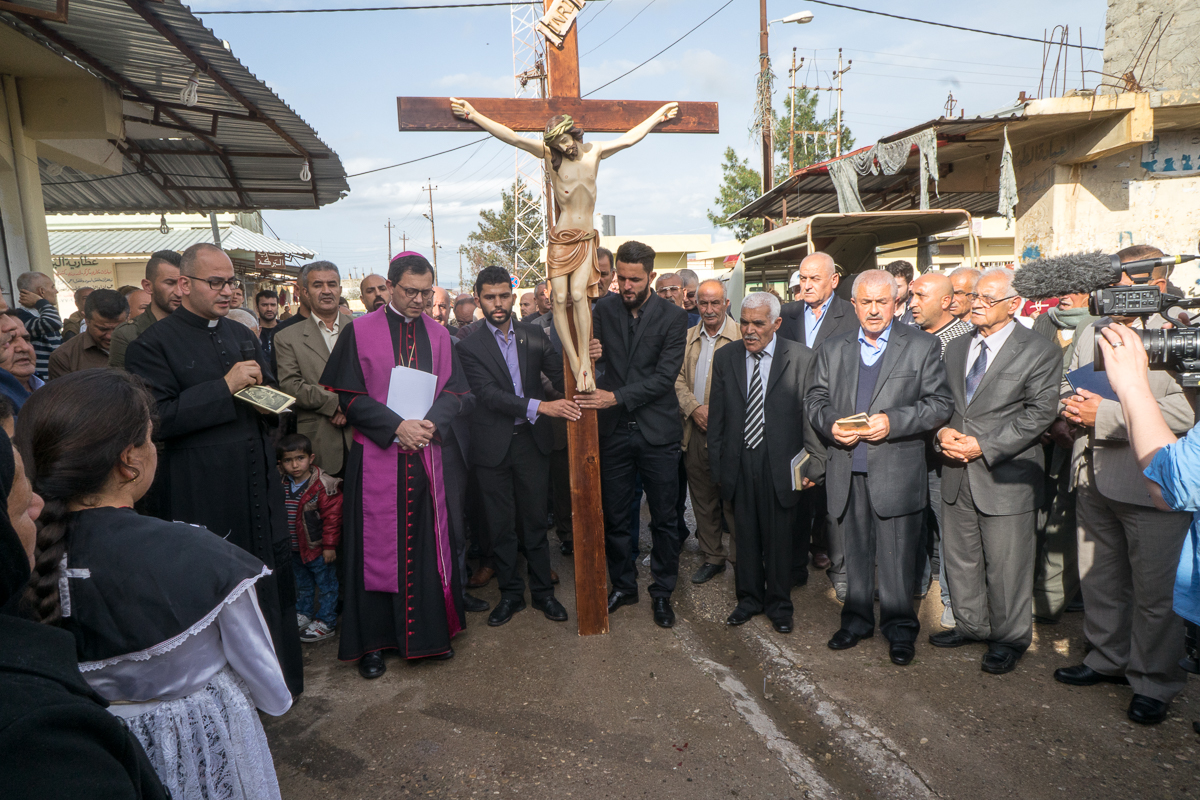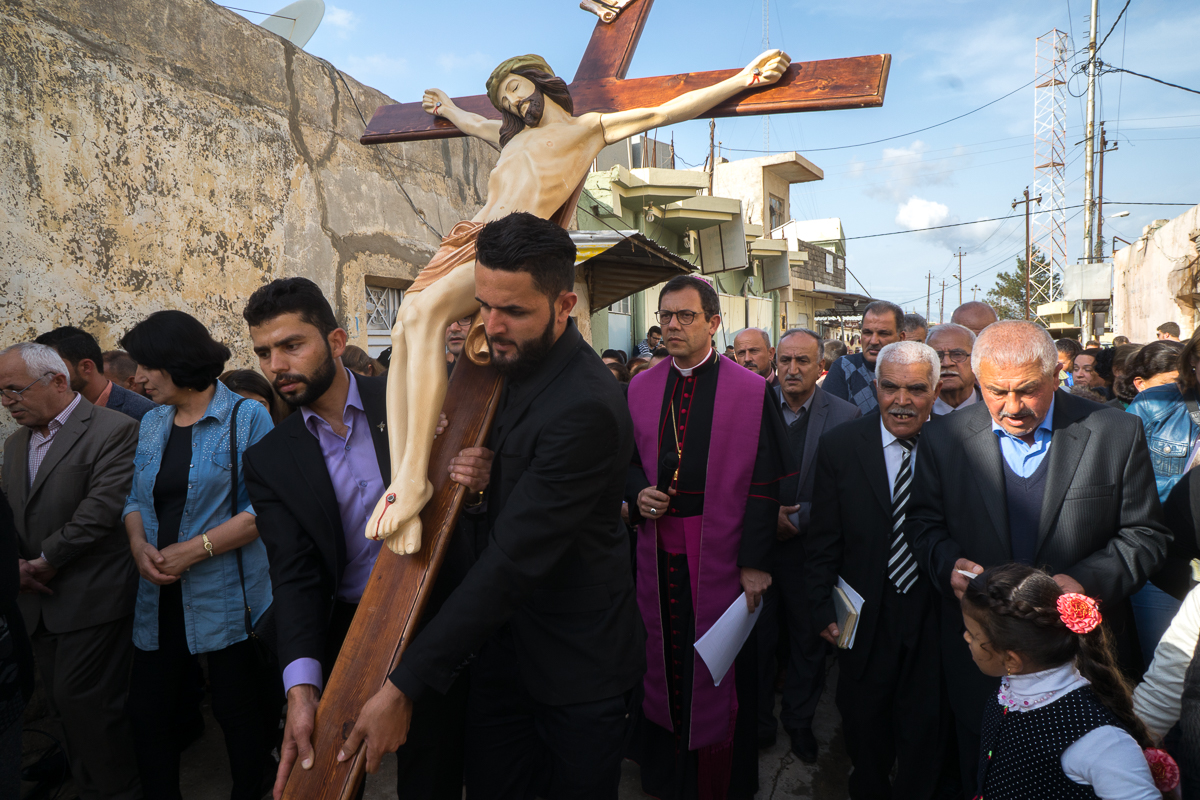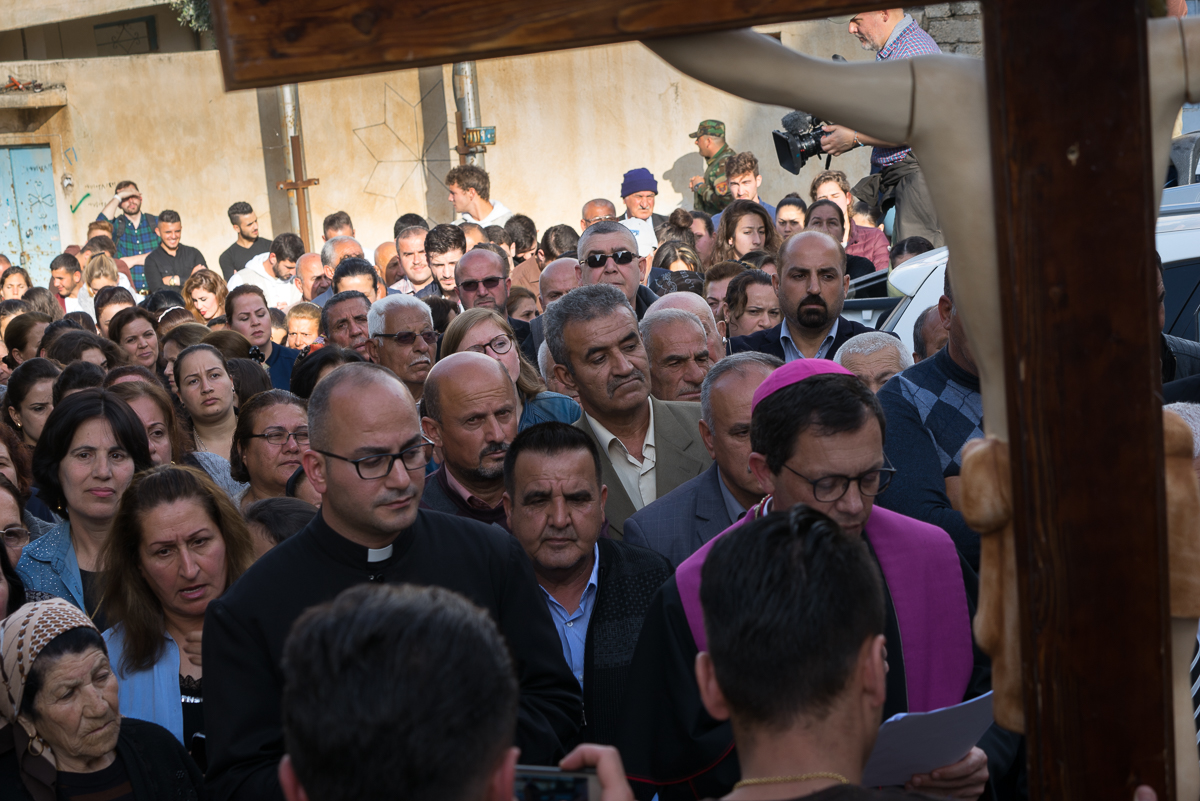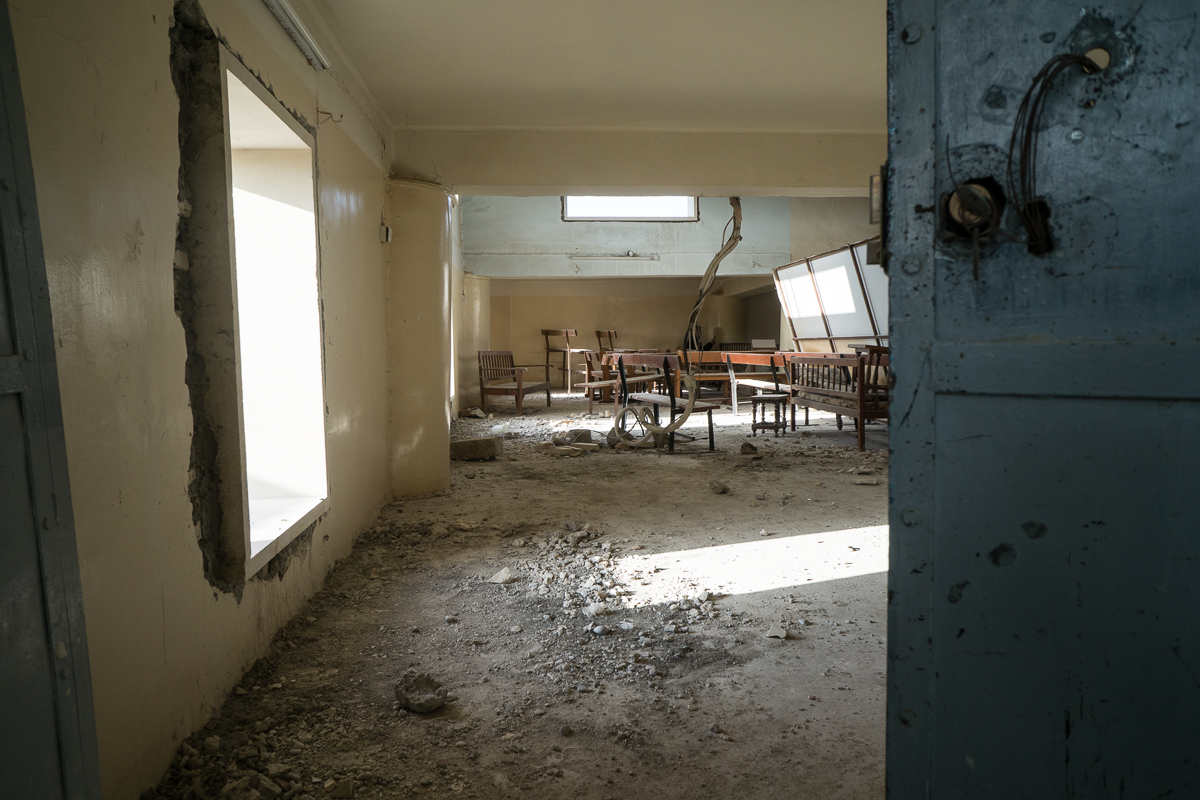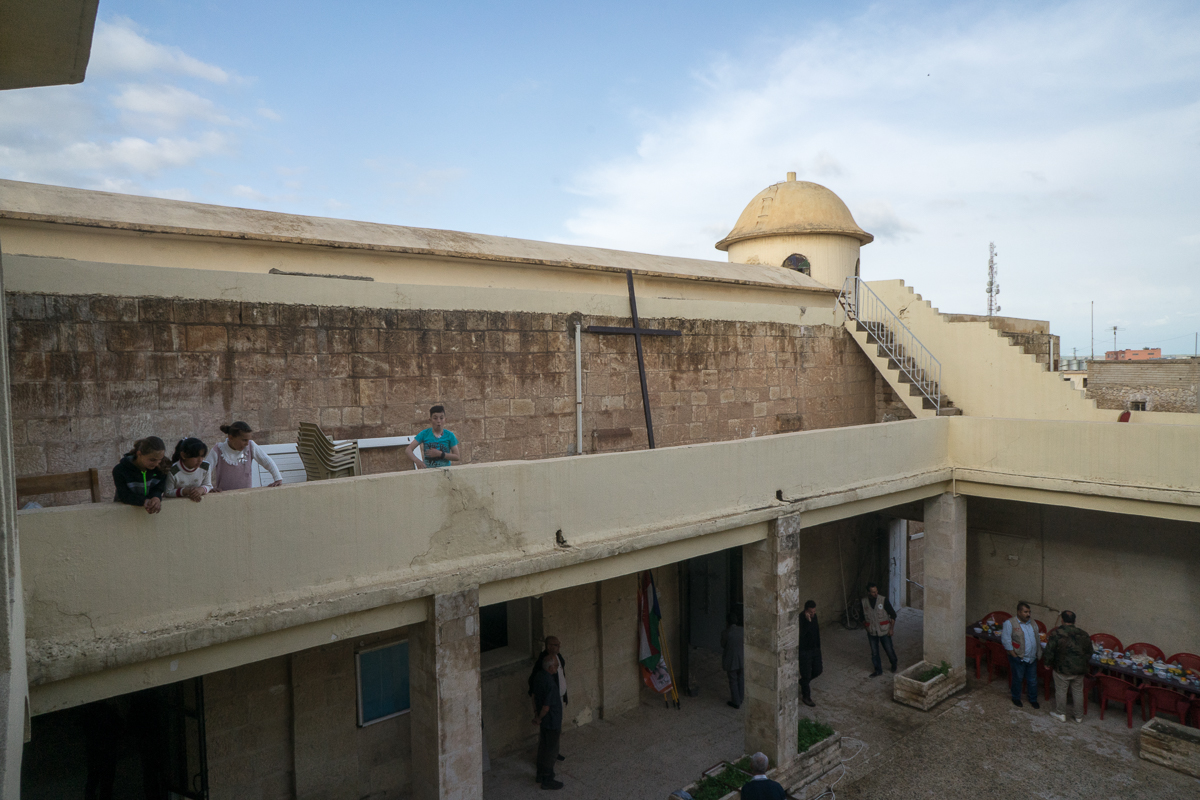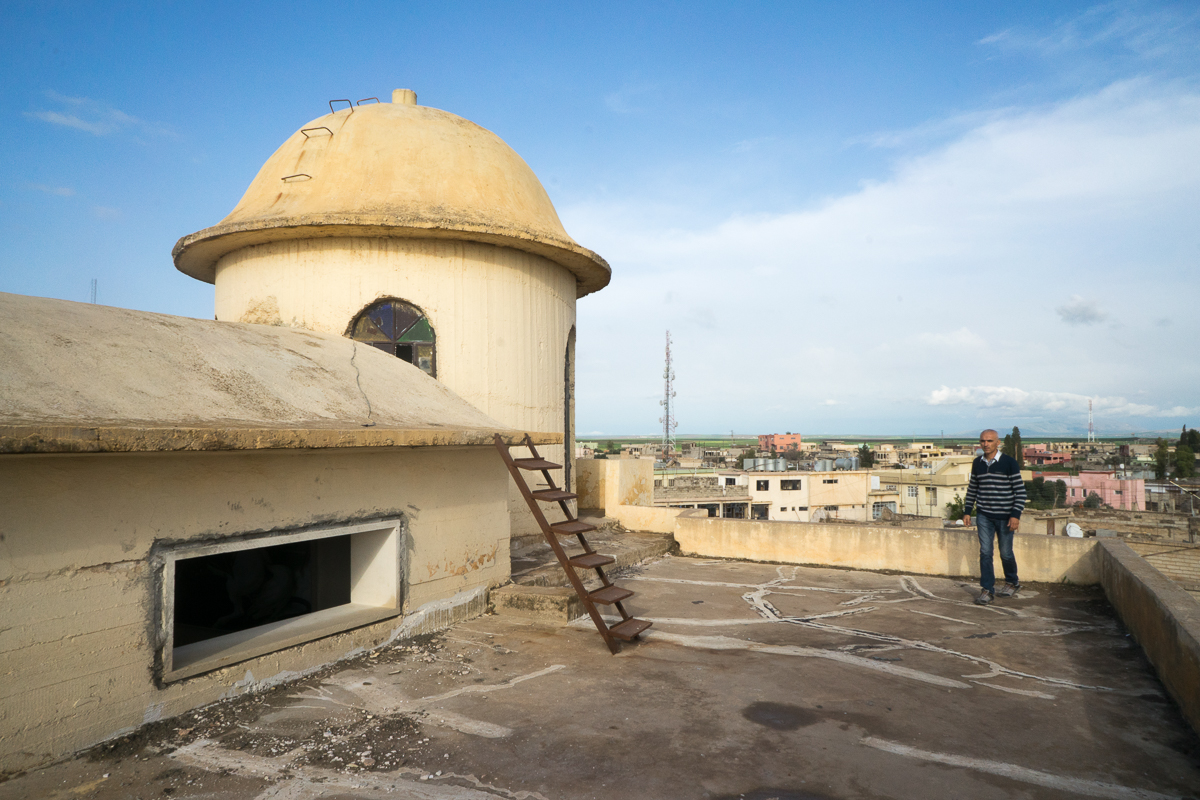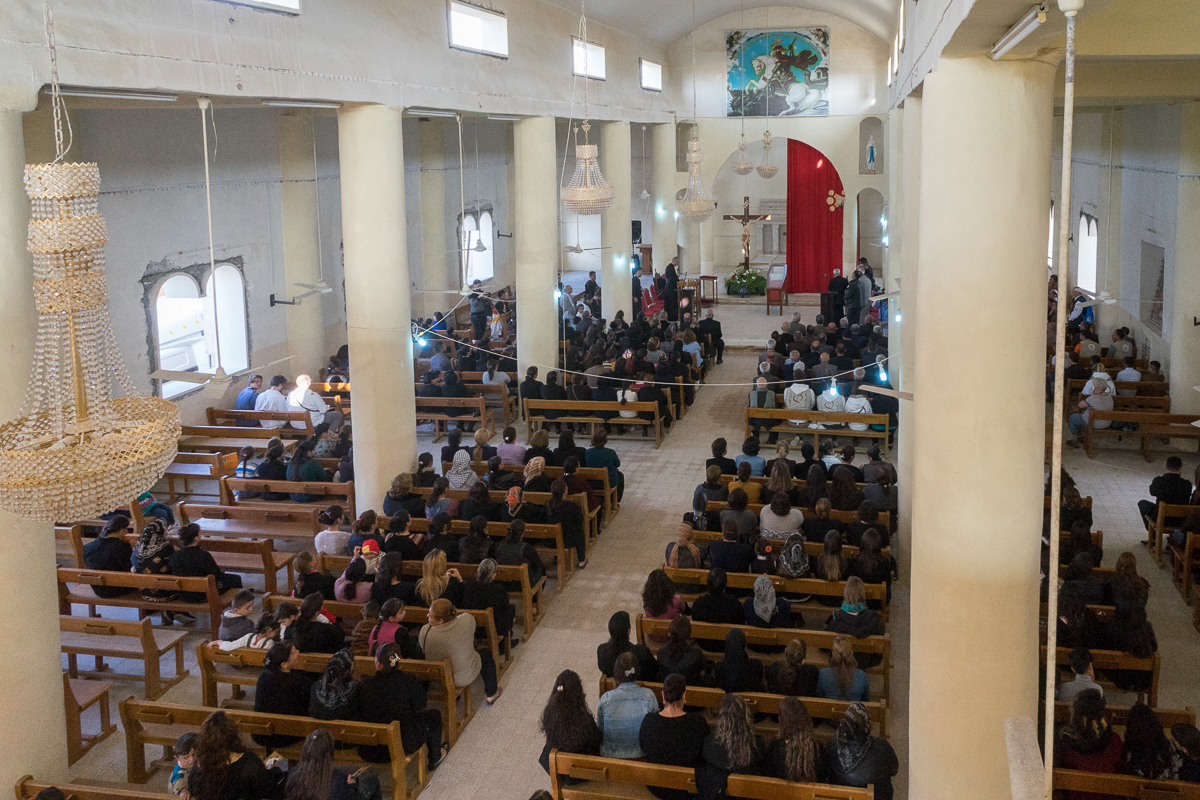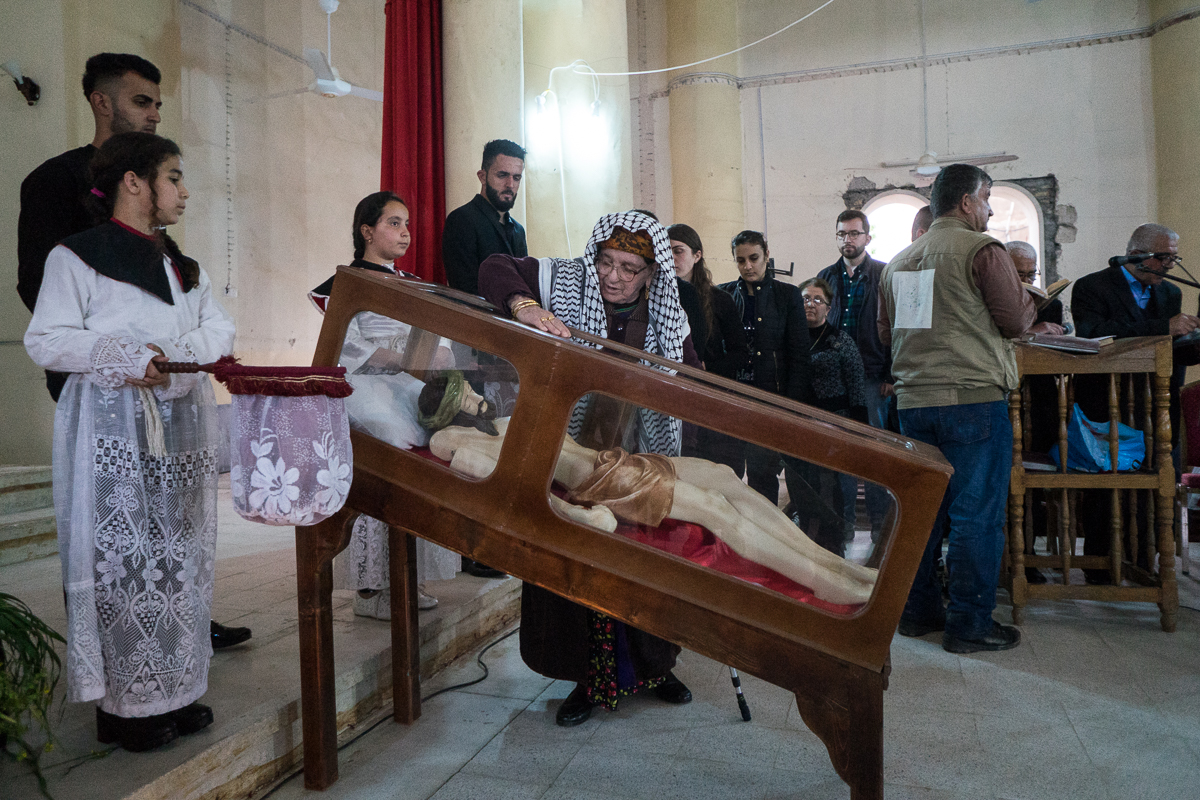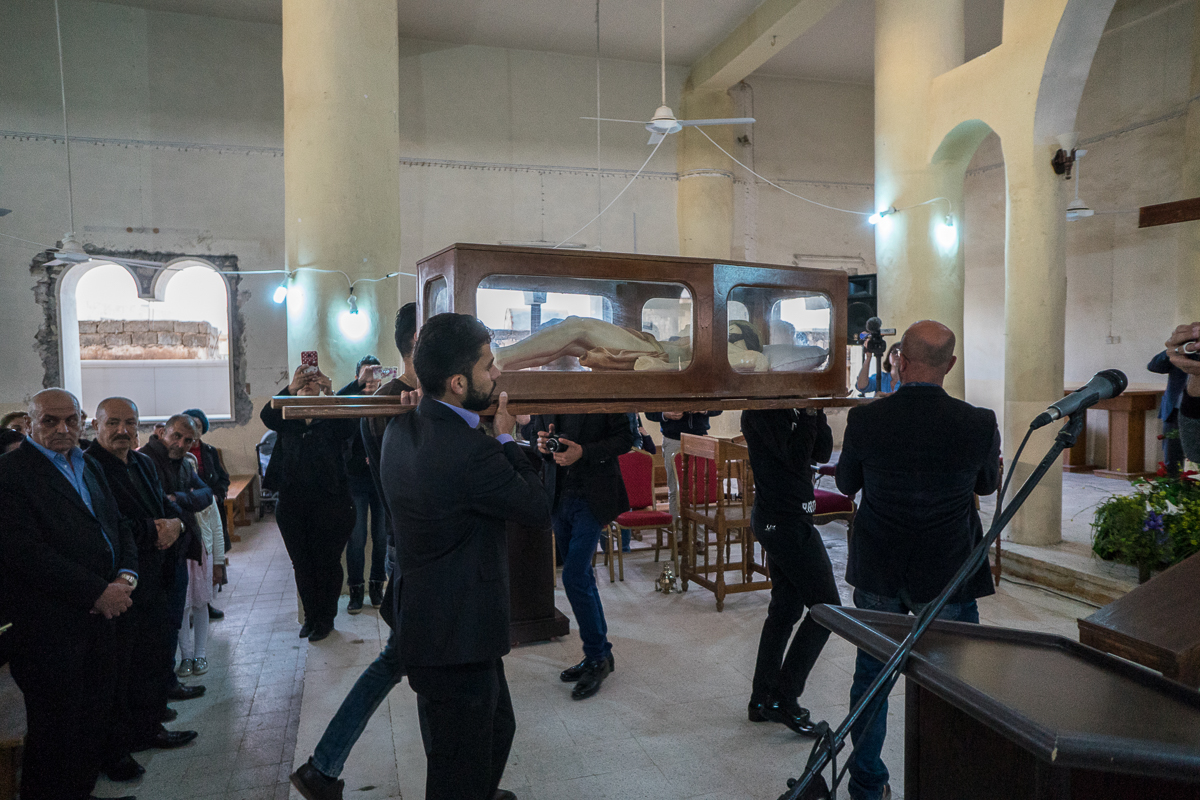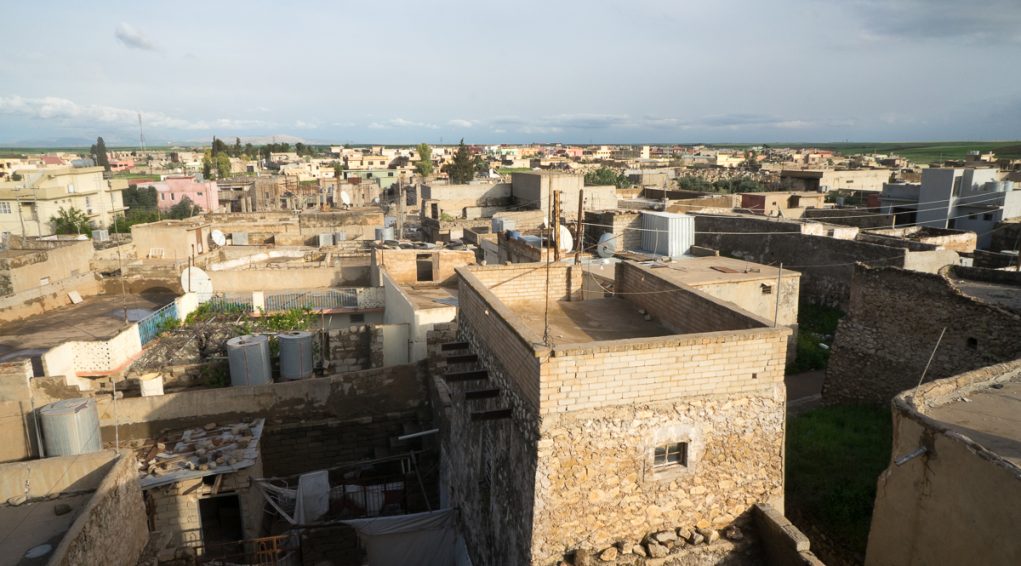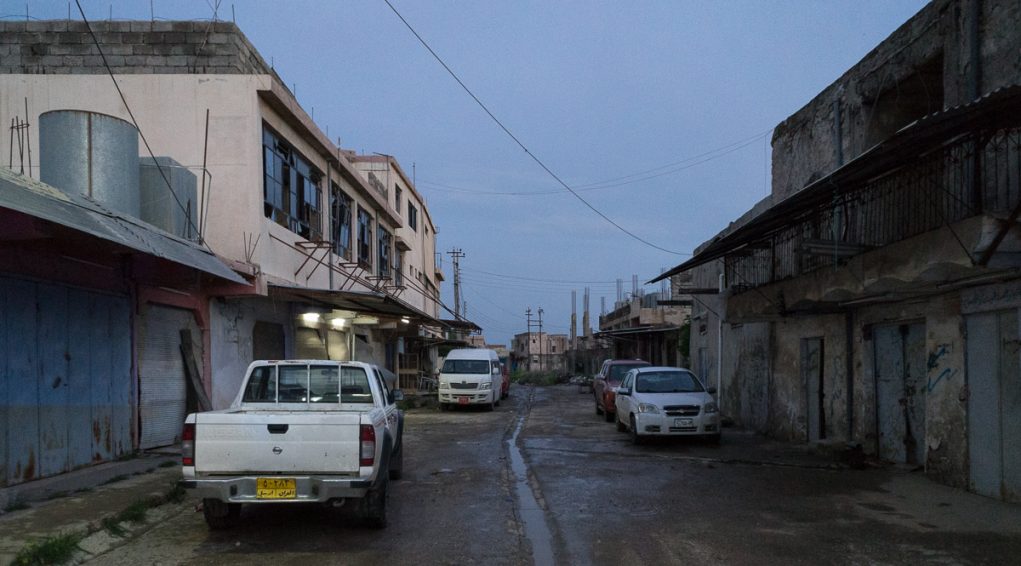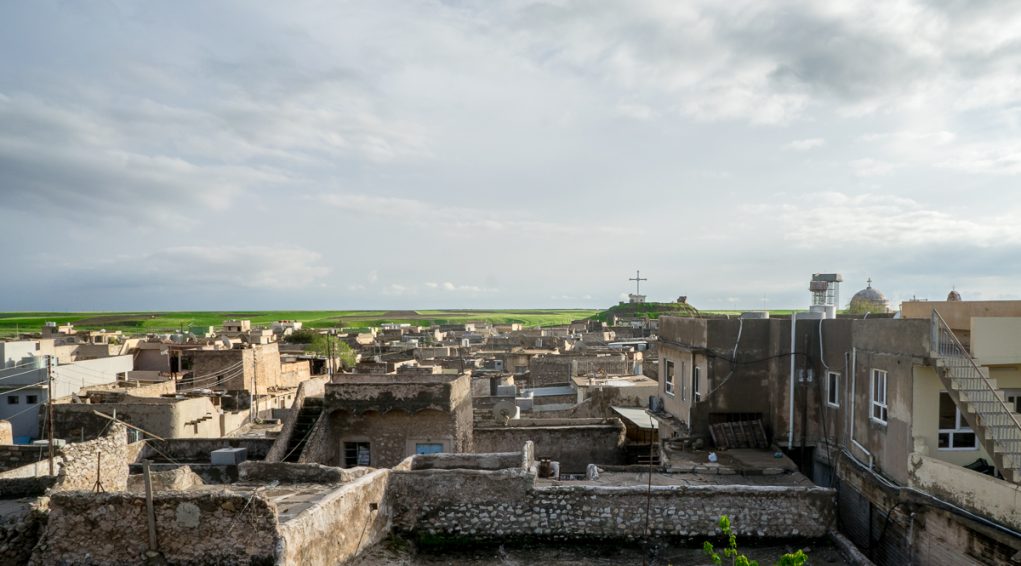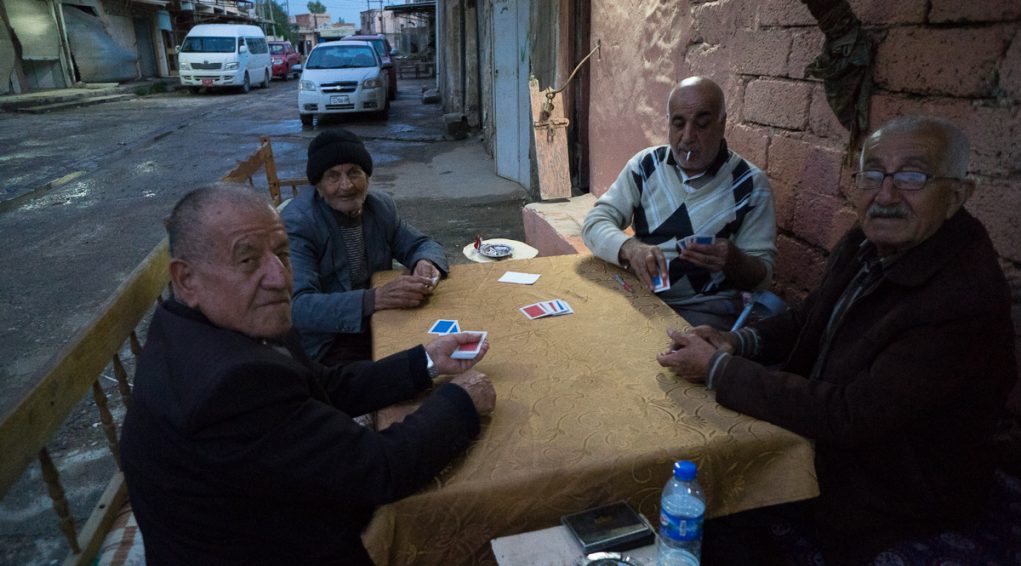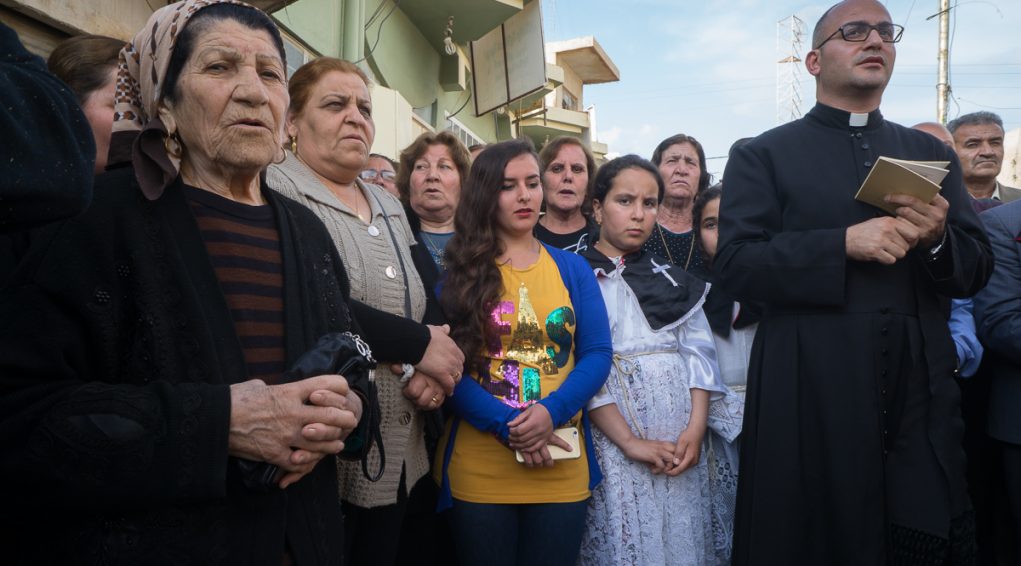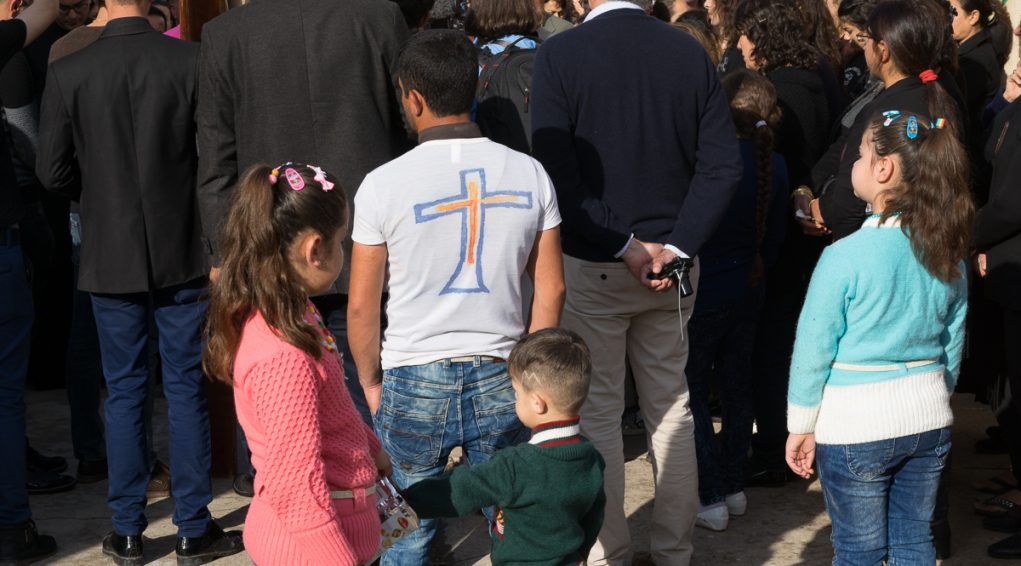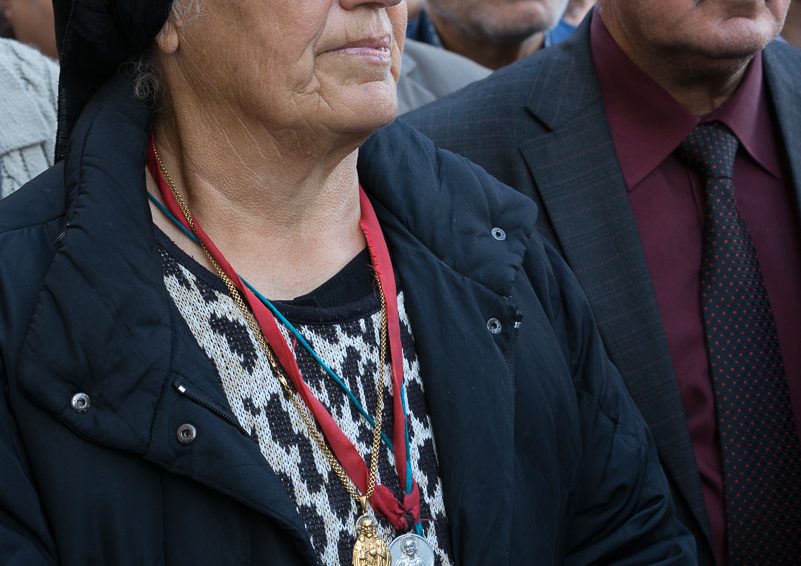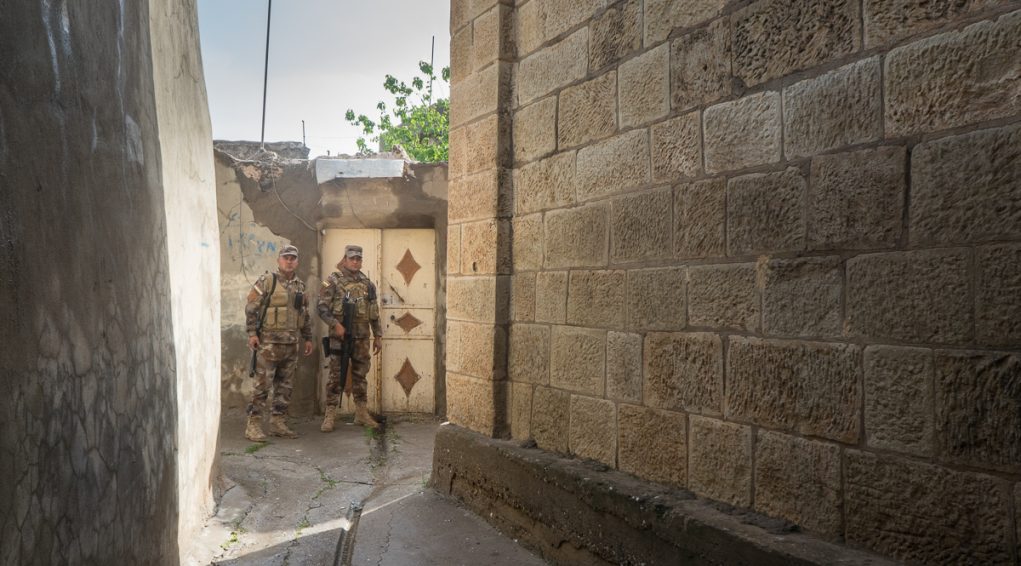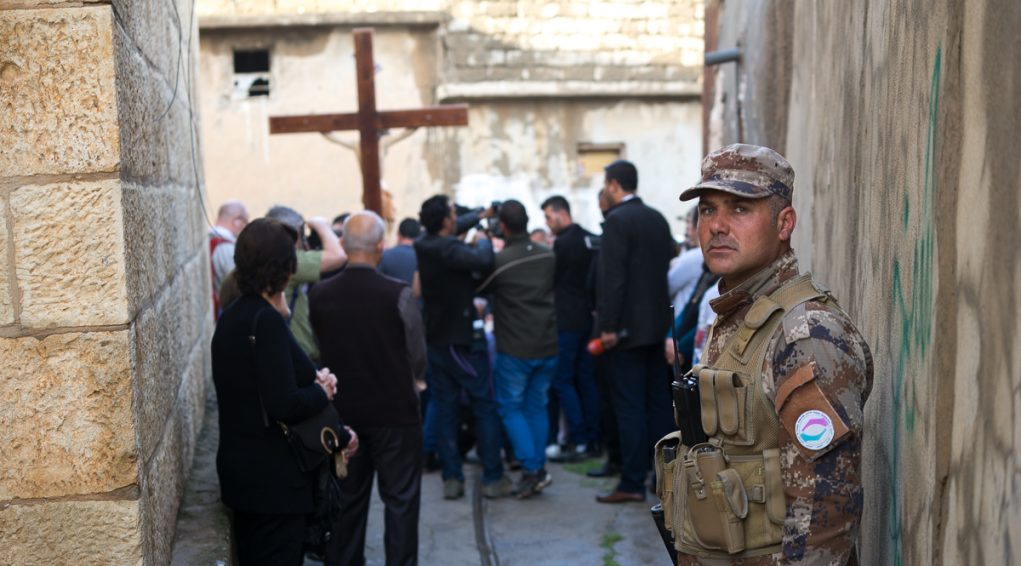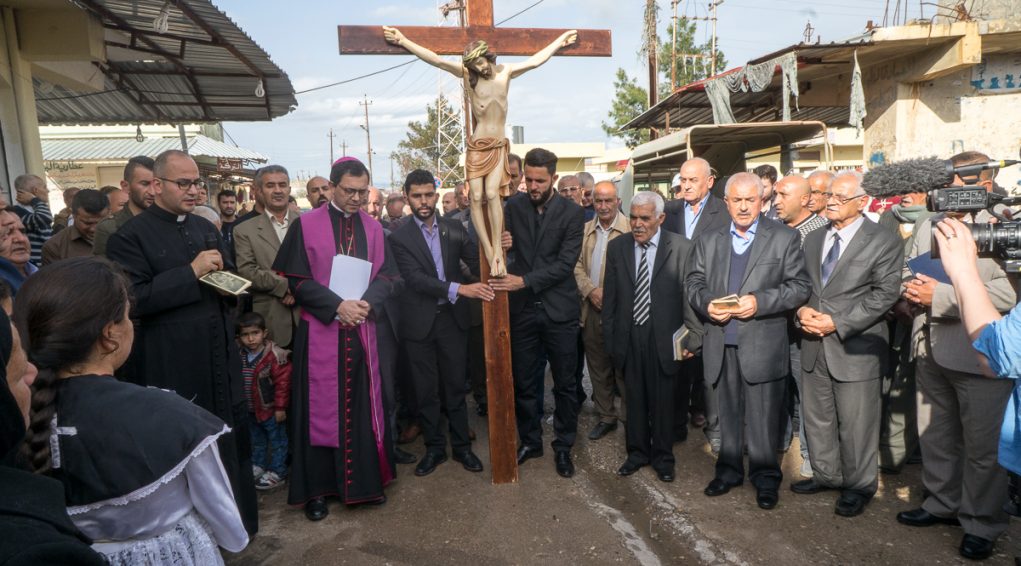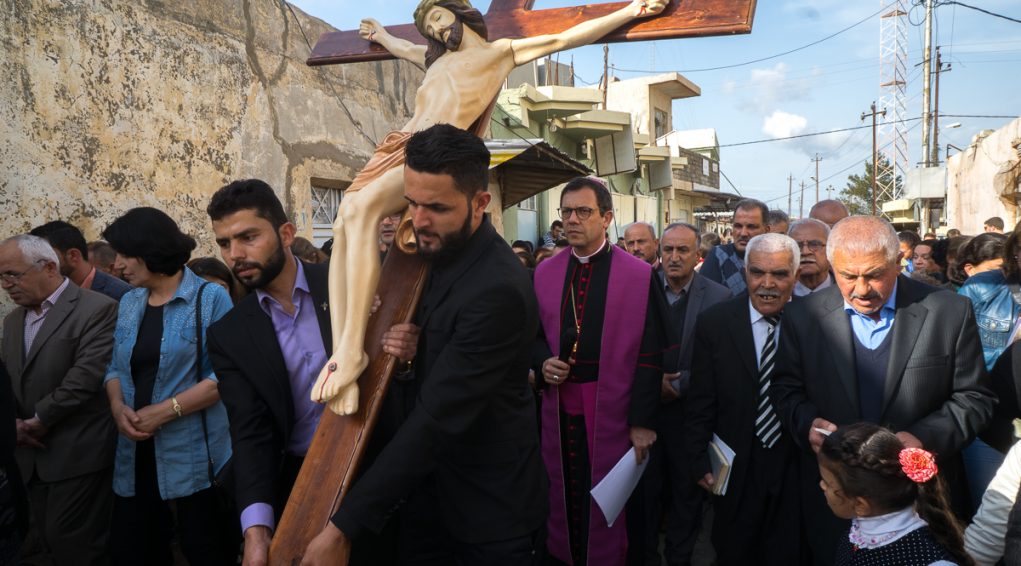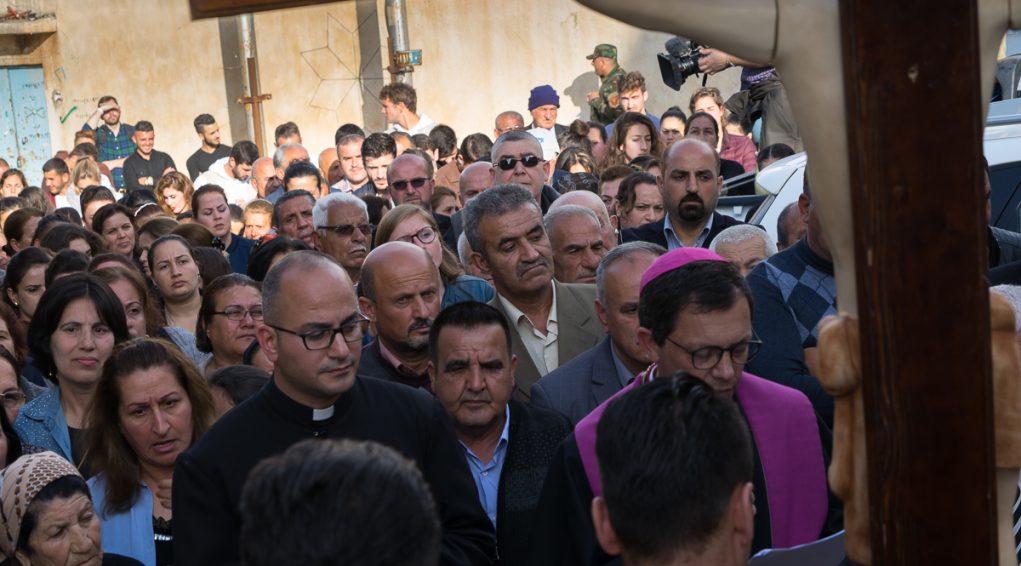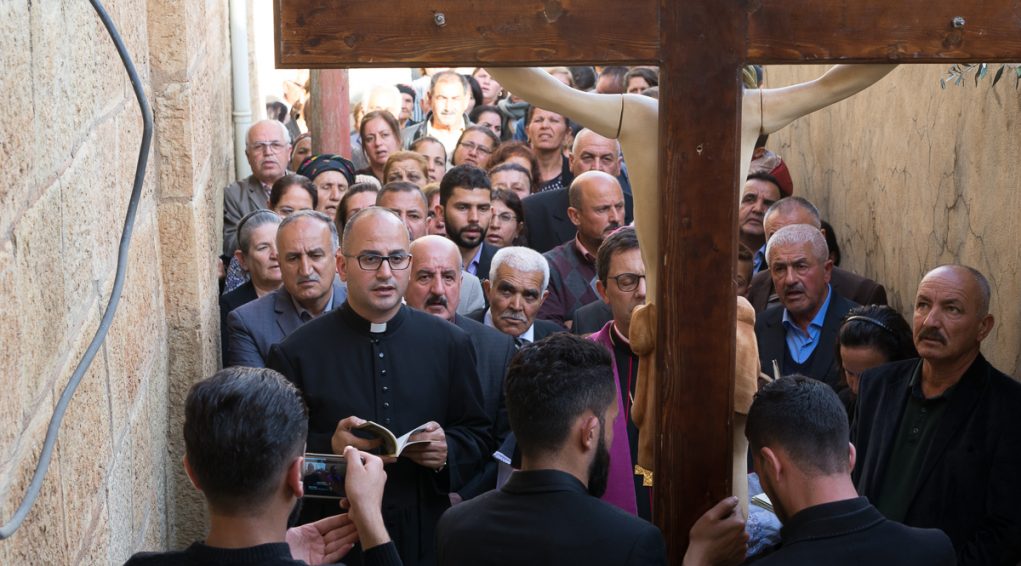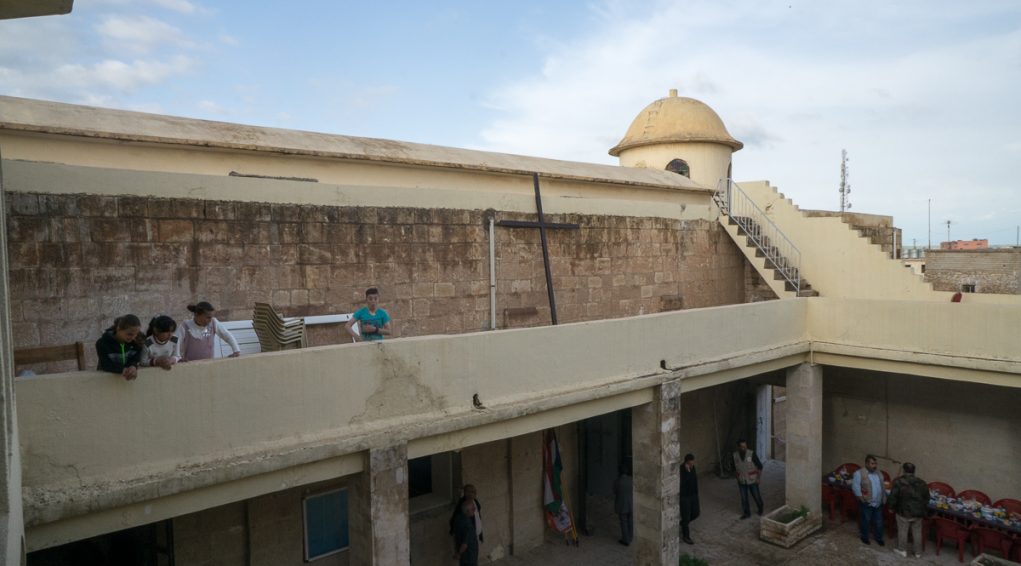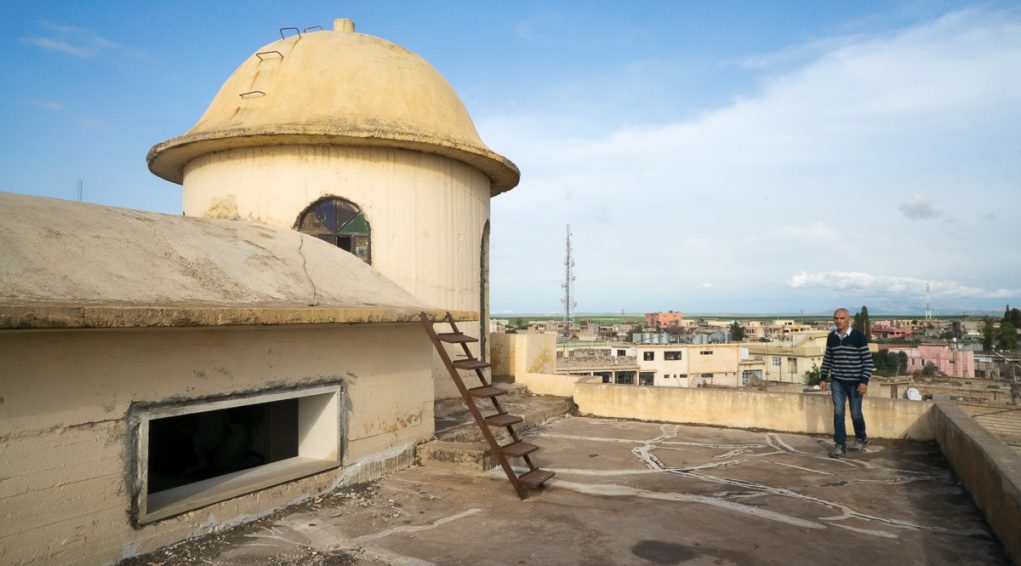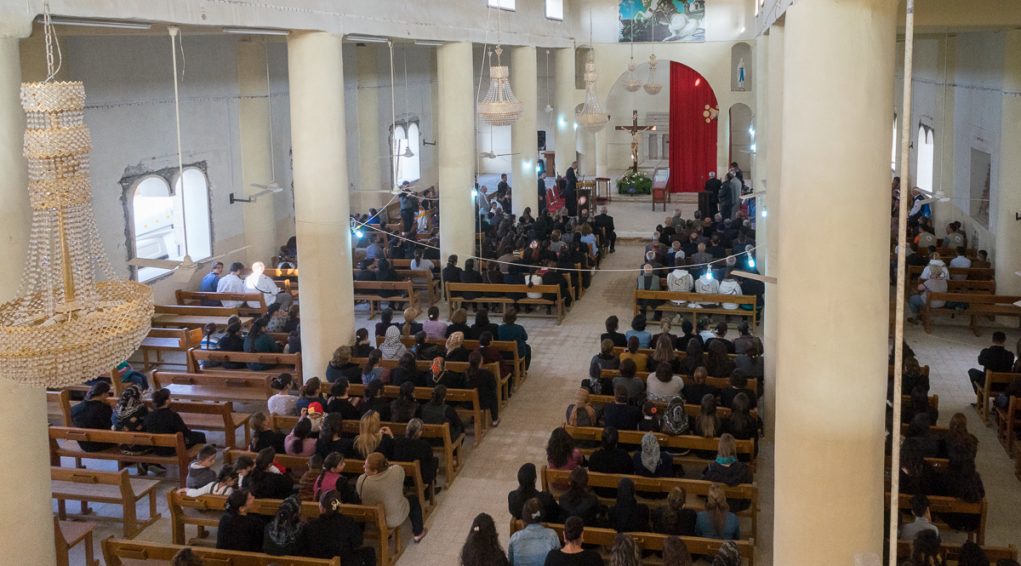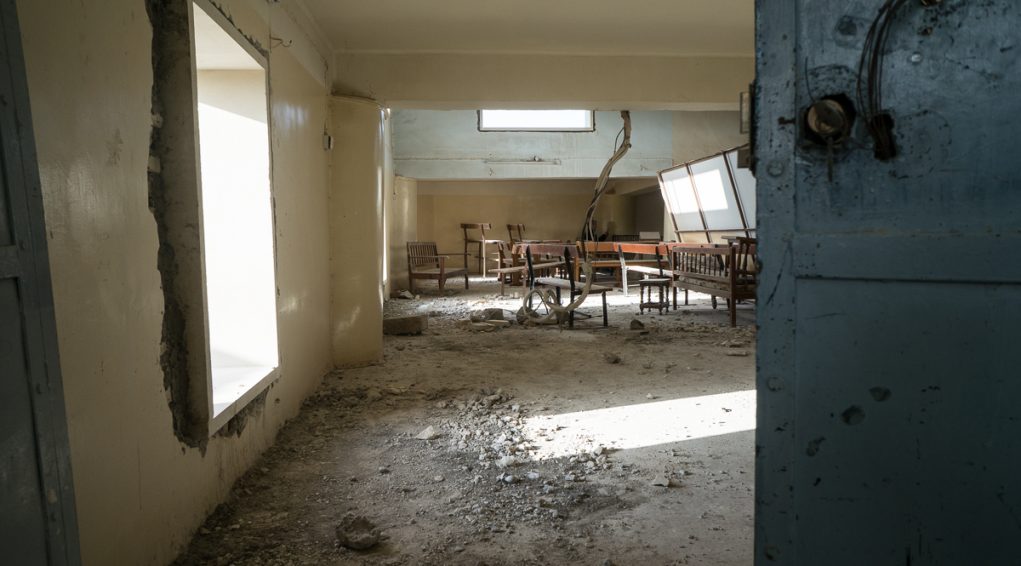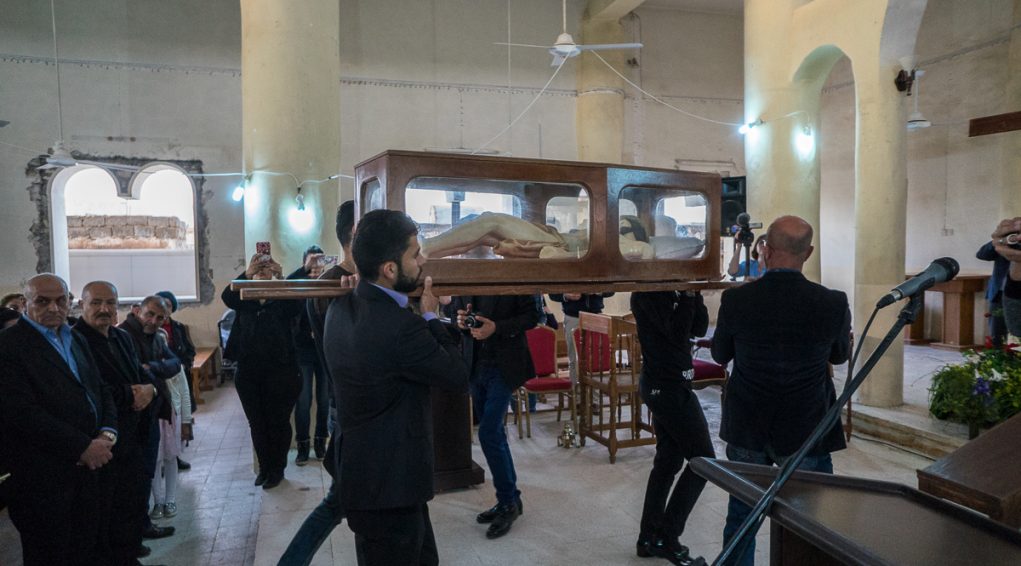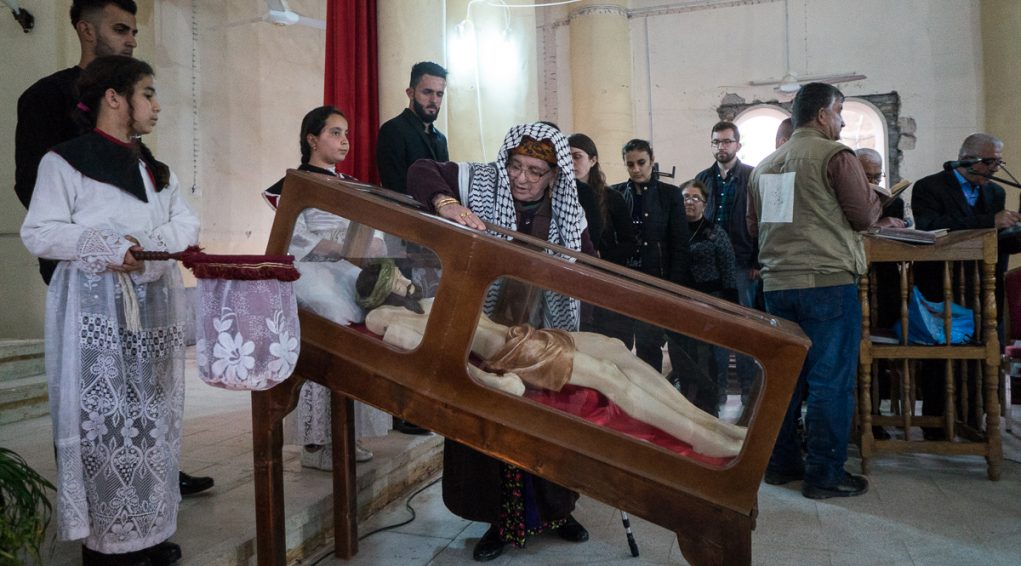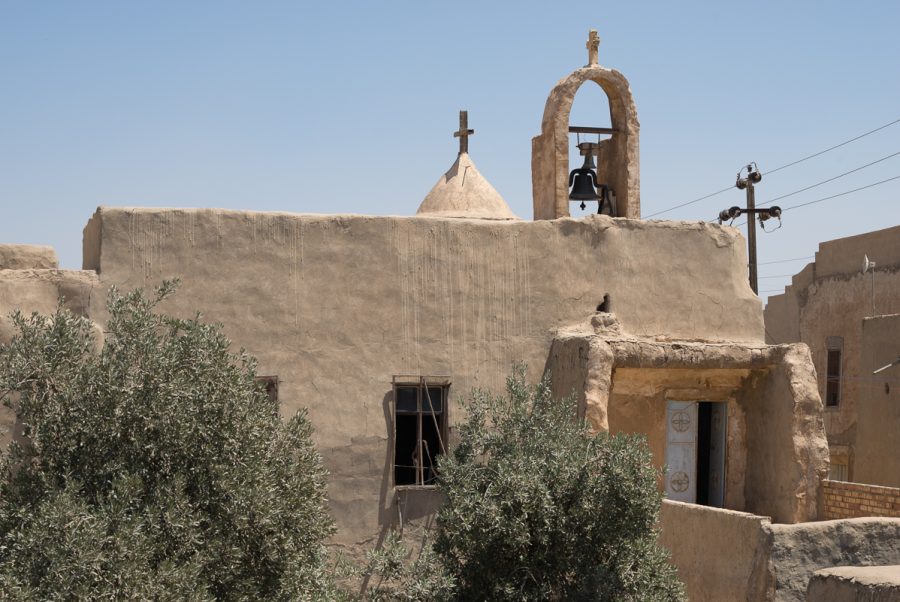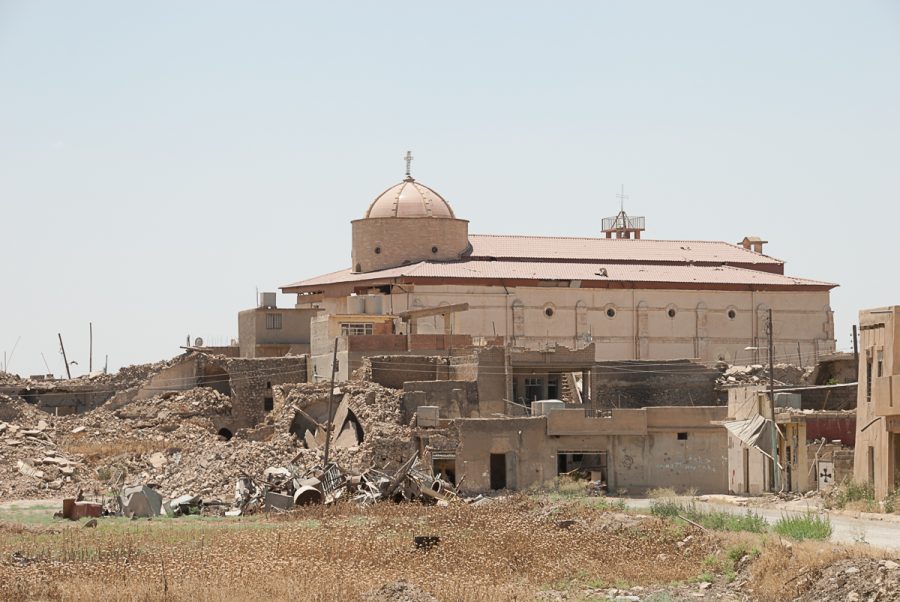The Mar Gorgis Church in Tell Esqof
The Mar Gorgis church in Tell Esqof is located at 36°35’54.8″N 43°06’17.1″E and 340 metres altitude. Tell Esqof is a very ancient Chaldean village.
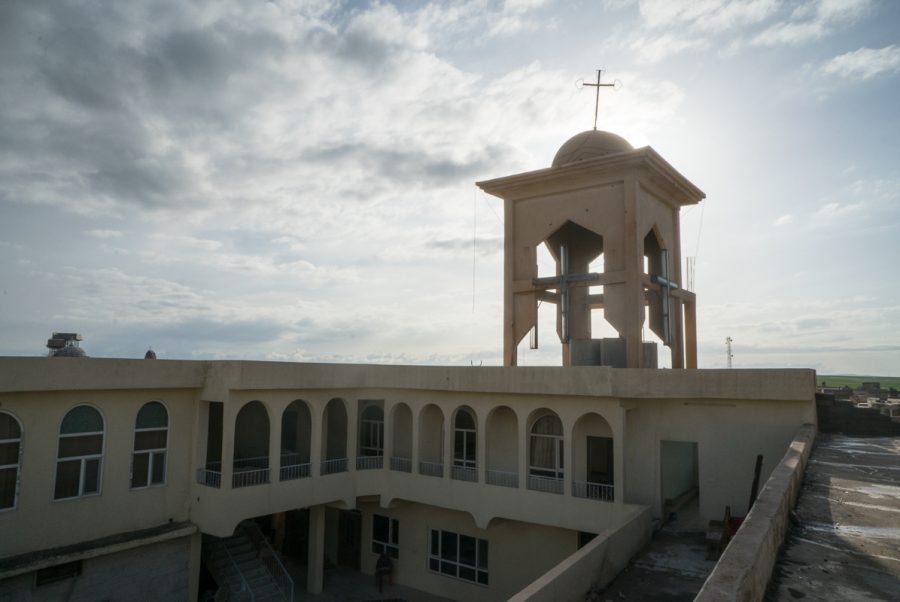
For centuries, despite the historical turbulence, Tell Esqof and its region, remained a major centre of Christianity. The main church in Tell Esqof is Mar Gorgis. This ancient church is attested to in a lectionary from 1499. Jean-Maurice Fiey visited it in 1943. Yet what he saw at that time was already destroyed in 1955! The new Mar Gorgis church was built in its place. This church is a vast triple nave basilica-style building, made of reinforced concrete with no charm and no decorative features.
On Friday 14 April 2017, Monsignor Emmanuel Gobilliard, auxiliary bishop of Lyon came to celebrate the Passion of Christ in Tell Esqof. Heading up a delegation from the diocese of Lyon, he completed the stations of the cross with Father Salar, priest of the Tell Escof and Baqofa parishes, along with several hundred of the village’s inhabitants.
Mar Gorgis Chaldean Church in Tell Esqof. April 2017 © Pascal Maguesyan / MESOPOTAMIA
Location
The Mar Gorgis church in Tell Esqof (Telskufin Arabic/ Tesqopain Syriac) is located at 36°35’54.8″N 43°06’17.1″E and 340 metres altitude.
Tell Esqof is situated on the eastern bank of the Tigris river, 32 km to the north of the centre of Mosul, 14 km to the north of Tell Kaif (Tell Kepe), 7 km north of Batnaya and 2 km north-west of Baqofa.
Toponymy, economy
The name of the village Tell Esqofcomes from the Syriac Tell Zqīpa, which means a high tell (hill).[1]
The agricultural activity mainly consists of arable and livestock farming. In the past, Tell Esqof was known for its pottery and weaving.
_______
[1]Source Jean-Maurice Fiey, in « Assyrie Chrétienne », vo.II, p. 381.
Demography of Tell Esqof
Tell Esqofis a Chaldean village. Like many of the towns and villages in this region, the inhabitants of Tell Esqofleft the Holy Apostolic Catholic Assyrian Church of the East (also known as the Church of Persia or the Nestorian Church) for the Chaldean Church (in communion with Rome) in the 18th century.
In 1852, George Percy Badger[1]reported 110 families in the village. In 1891, the geographer Vital Cuinet counted 1,500 inhabitants[2]. In the twentieth century, around 1965, there were 3,500 to 5,705 inhabitants. Before the arrival of ISIS, in August 2014, Tell Esqofhad a population of around 11,000 inhabitants[3].
_______
[1]See G.P.Badger « The Nestorians and their rituals », London, Joseph Masters, II. P.174
[2]In La Turquie d’Asie, Vital Cuinet, Ernest Leroux éditeur, Paris, 1891, p. 831.
[3]Source Jean-Maurice Fiey, in « Assyrie Chrétienne », vo.II, p. 381.
Fragments of Christian history
According to the tradition, Christianity entered the Nineveh plain at the end of the 4th century or the beginning of the 5th century. More surely, sources speak of evangelization during the 7th century. It was the monk Abraham (Awrāha / Oraha), a contemporary of the patriarch of the Church of the East Ishoʿyahb II (628-645) who was accredited with spreading the faith in the villages in the region. His monastery, left to abandon, is located 8 kilometres away at the exit to Batnaya.
Throughout the centuries, the Christian cities of Mesopotamia have suffered from all types of destruction. In 1235, Bar Hebraeus, a Maphrian Syriac-Orthodox scholar and writer, recounts the onslaught and destruction of the Mongols (Tartars). It was also the Mongols who looted the town in 1436. They massacred some of the inhabitants and destroyed the churches and harvests. They returned one last time in 1508, with their chief Bar Yak, who also attacked Tell Kaif, Alqosh and the monastery of Rabban Hormizd[1].
In 1743 the Persian emperor Nader Shah attacked, plundered and ruined the village, as he had done throughout the region. We also know that there was more than one outbreak of the plague in Mosul and the Nineveh plain, notably in 1737/38, 1773, then 1828.
_______
[1]See the 1821 manuscript by Father Gabriel, translated into French by Monsignor Addaï Scher (who died martyred on 17 June 1915) and published in “Journal Asiatique”. Source Joseph Alichoran and his contribution “Chrétiens d’Irak: ce n’est pas la fin !”, extract from the conference “Vers un nouveau Moyen-Orient… La fin des chrétiens ?” AED, on 5 December 2014.
The recent history of Tell Esqof: 2014-2017
The inhabitants of Tell Esqofwere forced to flee to Iraqi Kurdistan when ISIS advanced into the Nineveh plain at the start of August 2014. The Islamist fighters were chased out of Tell Esqof by the Kurdish Peshmerga on 17 August. Nine months later, on 3 May 2016, ISIS took back Tell Esqof but were forced out later the same day. Since ISIS was defeated in the Nineveh plain in October 2016, the villagers have progressively returned home, with support from international development organisations.
However, on 24 October 2017, the population of Tell Esqof fled the village again due to skirmishes between the Kurdish Peshmerga and government forces due to tensions arising from the independence referendum for Iraqi Kurdistan. Tell Esqof is indeed located in a “grey” zone controlled de factoby Iraqi Kurdistan but over which the government in Baghdad has reasserted its administrative authority.
The churches of Tell Esqof
For centuries, despite the historical turbulence, Tell Esqof and its region, remained a major centre of Christianity. “In 1607, there were 30 Nestorian and 35 Syriac monasteries active in the region. In 1957, ten monasteries still played an important socio-cultural role for the villagers and the inhabitants of Mosul who came to spend weekends here as a family, taking part in the morning services, consulting the monks but also dancing and singing in the outbuildings. Scholars were able to consult manuscripts copied from one generation to another (…).”[1]
In the last century there were still traces to be found of numerous churches in the region of Tell Esqof. These include the monastery of Apnimaran, now covered by a cemetery, to the east of Tell Esqof, Mar Sahdonna to the north-west, Mart Shmoni to the south, the well of the unmarried, location of an ancient monastery to the north (…). [2]
At the centre of Tell Escoff is the church of Mar Yacoub al Mouqataa (Saint James Intercisus). The left side aisle was replaced by a new church which flanks the ancient building.
The main church in Tell Esqof is Mar Gorgis. The ancient church is attested to in a lectionary dating from 1499 along with the Saint James Intercisus church. Jean-Maurice Fiey visited it in 1943. Yet what he saw at that time was destroyed in 1955! The new Mar Gorgis church was built in its place.[3]
_______
[1]In “Qaraqoche ou la disparition des chrétiens de la plaine de Ninive.” Christian Lochon, Honorary Director of Studies at the CHEAM, Revue de l’Œuvre d’Orient, 2015, p.138
[2]Source Jean-Maurice Fiey, in « Assyrie Chrétienne », vo.II, p. 383-386
[3]British Museum, cod. Rich 7174, Catalogue V. Rosen-J. Forshall, n°XXX, cited by Jean-Maurice Fiey, in « Assyrie Chrétienne », vol. II. P.383
Description of the Mar Gorgis church in Tell Esqof
This church is a vast triple nave basilica-style building, made of reinforced concrete with no charm and no decorative features. The vault, semi-circular in the central part and flat over the side aisles, is supported by four pairs of freestanding pillars and load-bearing pillars. A large central arch and two smaller side arches separate the nave from the sanctuary. A red velvet curtain, embroidered with a large golden Chaldean cross, closes off the central arch. The high altar and its steps rests against the wall of the apse. Above the sanctuary is a cylindrical drum perforated with four light wells. The walls of the five transepts are also perforated with large windows. There are also light wells higher up on either side of the arch of the vault. A tribune, which runs the width of the building, is found on the western side of the building.
The Mar Gorgis church in Tell Esqof was vandalised by ISIS.
Solidarity with the Christians of Tell Esqof
On Friday 14 April 2017, Monsignor Emmanuel Gobilliard, auxiliary bishop of Lyon came to celebrate the Passion of Christ in Tell Esqof.
Heading up a delegation from the diocese of Lyon, he completed the stations of the cross with Father Salar, priest of the Tell Escof and Baqofa parishes, along with several hundred of the village’s inhabitants.
Celebrated in both French and Arabic at the foot of the hill, this way of the cross ended inside the Saint Georges church.
Monsignor Emmanuel Gobilliard spoke about it in these terms: “I saw Jesus in every face, in all their suffering, anxiety and uncertainty. In this martyred village, we had the feeling that the population was being carried by Jesus. It is Jesus himself who bears the suffering of these people. I felt very poor and humble faced with what they were going through. I wanted to embody the very deep-rooted connection we had developed with them through the Lyon Mosul twinning. The Holy Oil consecrated by the archbishop of Lyon, cardinal Philippe Barbarin, at the Chrism mass celebrated in Lyon, was mixed with the Holy Oil from Tell Esqof, as a sign of communion, unity and diversity.”
Numerous charities and international development organisations support the inhabitants of Tell Esqof through a plethora of humanitarian, economic, social and spiritual initiatives.
Monument's gallery
Monuments
Nearby
Help us preserve the monuments' memory
Family pictures, videos, records, share your documents to make the site live!
I contribute
